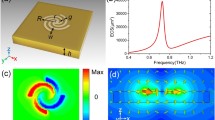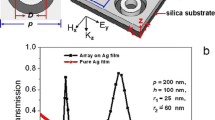Abstract
A planar metamaterial structure has been designed to obtain surface plasmon-induced-transparency (PIT) effect, which is composed of a nanodisk sandwiched between double rods. From theoretical perspective, the three-level plasmonic system has been utilized to analyze the near-field coupling mechanism. Besides, the simulation results show that PIT resonance can be tailored by structure parameters. Particularly, when the length of the rods is more than twice of the diameter of the disk, two PIT windows are generated simultaneously, based on the coupling between the bright mode of the nanodisk and two multipole dark modes of rods. Furthermore, a metamaterial structure, composed by a disk and two pairs of nanorods, is suggested to achieve the polarization-independent plasmon-induced-transparency effect. As a result, this work shows great application prospect in the area of compact optical devices, such as multiband tunable filters, plasmonic switches, and slow light devices.







Similar content being viewed by others
Data Availability
All other data that support the findings of this study are available from the corresponding author upon reasonable request.
References
Anker JN, Hall WP, Lyandres O, Shah NC, Zhao J, Van Duyne RP (2008) Biosensing with plasmonic nanosensors. Nat Mater 7(6):442–453
Qi JX, Miao RC, Li CX, Zhang MD, Wu YN, Wang C, Dong J (2018) Tunable multiple plasmon resonances and local field enhancement of a structure comprising a nanoring and a built-in nanocross. Opt Commun 421(15):19–24
Safavi-Naeini AH, Mayer Alegre TP, Chan J, Eichenfield M, Winger M, Lin Q, Hill JT, Chang DE, Painter O (2011) Electromagnetically induced transparency and slow light with optomechanics. Nature 472(7341):69–73
Liu N, Langguth L, Weiss T, Kästel J, Fleischhauer M, Pfau T, Giessen H (2009) Plasmonic analogue of electromagnetically induced transparency at the drude damping limit. Nat Mater 8(9):758–762
Jia W, Ren PW, Jia YL, Fan CZ (2019) Active control and large group delay in graphene-based terahertz metamaterials. J Phys Chem C 123(30):18560–18564
Hu M, Wang FQ, Liang RS, Zhou SW, Xiao LP (2015) Plasmonic-induced transparency based on plasmonic asymmetric dual side-coupled cavities. Phys Lett A 379(6):581–584
Sekkat Z, Hayashi S, Nesterenko DV, Rahmouni A, Refki S, Ishitobi H, Inouye Y, Kawata S (2016) Plasmonic coupled modes in metal-dielectric multilayer structures: fano resonance and giant field enhancement. Opt Express 24(18):20080–20088
Gu JQ, Singh RJ, Liu XJ, Zhang XQ, Ma YF, Zhang S, Maier SA, Tian Z, Azad AK, Chen HT, Taylor AJ, Han JG, Zhang WL (2012) Active control of electromagnetically induced transparency analogue in terahertz metamaterials. Nat Commun 3:1151
Palinginis P, Sedgwick F, Crankshaw S, Moewe M, Chang-Hasnain CJ (2005) Room temperature slow light in a quantum-well waveguide via coherent population oscillation. Opt Express 13(24):9909–9915
Lu XQ, Shi JH, Liu R, Guan CY (2012) Highly-dispersive electromagnetic induced transparency in planar symmetric metamaterials. Opt Express 20(16):17581–17590
Cao W, Singh R, Zhang CH, Han JG, Tonouchi M, Zhang WL (2013) Plasmon-induced transparency in metamaterials: active near field coupling between bright superconducting and dark metallic mode resonators. Appl Phys Lett 103(10):101106
Yahiaoui R, Burrow JA, Mekonen SM, Sarangan A, Mathews J, Agha I, Searles TA (2018) Electromagnetically induced transparency control in terahertz metasurfaces based on bright-bright, mode coupling. Phys Rev B 97:155403
Tang PR, Li J, Du LH, Liu Q, Peng QX, Zhao JH, Zhu B, Li ZR, Zhu LG (2018) Ultrasensitive specific terahertz sensor based on tunable plasmon induced transparency of a graphene micro-ribbon array structure. Opt Express 26(23):30655–30666
Ma Q, Zhan YW, Hong WY (2019) Tunable metamaterial with gold and graphene split-ring resonators and plasmonically induced transparency. Nanomaterials 9(1):7
Asgari S, Shokati E, Granpayeh N (2019) High-efficiency tunable plasmonically induced transparency-like effect in metasurfaces composed of graphene nano-rings and ribbon arrays and its application. Appl Opt 58(13):3664–3670
Gao ED, Liu ZM, Li HJ, Xu H, Zhang ZB, Luo X, Xiong CX, Liu C, Zhang BH, Zhou FQ (2019) Dynamically tunable dual plasmon-induced transparency and absorption based on a single-layer patterned graphene metamaterial. Opt Express 27(10):13884–13894
Zhang S, Genov DA, Wang Y, Liu M, Zhang X (2008) Plasmon-induced transparency in metamaterials. Phys Rev Lett 101(4):047401
Manjappa M, Turaga SP, Srivastava YK, Bettiol AA, Singh R (2017) Magnetic annihilation of the dark mode in a strongly coupled bright-dark terahertz metamaterial. Opt Lett 42(11):2106–2109
Devi KM, Sarma AK, Chowdhury DR, Kumar G (2017) Plasmon induced transparency effect through alternately coupled resonators in terahertz metamaterial. Opt Express 25(9):10484–10493
Yahiaoui R, Manjappa M, Srivastava YK, Singh R (2017) Active control and switching of broadband electromagnetically induced transparency in symmetric metadevices. Appl Phys Lett 111:021101
Xu Q, Su XQ, Ouyang CM, Xu NN, Cao W, Zhang Y, Li Q, Hu C, Gu JQ, Tian Z, Azad AK, Han JG, Zhang WL (2016) Frequency-agile electromagnetically induced transparency analogue in terahertz metamaterials. Opt Lett 41(19):4562–4565
Xiao SY, Wang T, Liu TT (2018) Active modulation of electromagnetically induced transparency analogue in terahertz hybrid metal-graphene metamaterials. Carbon 126:271–278
Ling YH, Huang LR, Hong W, Liu TJ, Luan J, Liu WB, Lai JJ, Li HP (2018) Polarization-controlled dynamically switchable plasmon-induced transparency in plasmonic metamaterial. Nanoscale 10:19517–19523
Meng FY, Wu Q, Erni D, Wu K, Lee J (2012) Polarization-independent metamaterial analog of electromagnetically induced transparency for a refractive-index-based sensor. IEEE Trans Microw Theory Tech 60(10):3013–3022
Liu TT, Wang HX, Liu Y, Xiao LS, Zhou CB, Liu YB, Xu C, Xiao SY (2018) Independently tunable dual-spectral electromagnetically induced transparency in a terahertz metal-graphene metamaterial. J Phys D: Appl Phys 51:415105
Johnson PB, Christy RW (1972) Optical constants of the noble metals. Phys Rev B 6:4370–4379
Chen H, Chen SQ, Yu P, Duan XY, Xie BY, Tian J (2013) Dynamically tunable plasmonically induced transparency in periodically patterned graphene nanostrips. Appl Phys Lett 103(20):203112
Acknowledgments
We thank Prof. Fan-Yi Meng From Harbin Institute of Technology for his helpful advices.
Funding
This work was supported by the Shaanxi Provincial Education Department (Program No. 17JF026).
Author information
Authors and Affiliations
Contributions
All authors have participated in (a) conception and design or analysis and interpretation of the data; (b) approval of the final version, and (c) Jianxia Qi and Jun Dong drafting the article and revising it critically for important intellectual content.
Corresponding authors
Ethics declarations
Conflict of Interest
The authors declare that they have no conflict of interest.
Consent to Participate
Informed consent was obtained from all authors.
Consent to Publish
All authors agree to publish these papers.
Additional information
Publisher’s Note
Springer Nature remains neutral with regard to jurisdictional claims in published maps and institutional affiliations.
Rights and permissions
About this article
Cite this article
Qi, J., Zhang, Y., Wang, Y. et al. Tunable Plasmon-Induced-Transparency Effect in a Simple Planar Composite Structure. Plasmonics 16, 965–972 (2021). https://doi.org/10.1007/s11468-020-01362-w
Received:
Accepted:
Published:
Issue Date:
DOI: https://doi.org/10.1007/s11468-020-01362-w




